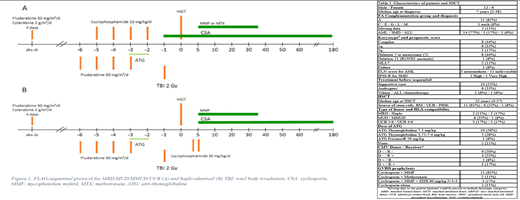
Background: Fanconi anemia (FA) is the most frequent genetic cause of bone marrow failure (BMF) due to a DNA repair mechanism defect. The natural history of FA is marked by progressive BMF during early childhood. Throughout life, the hematopoietic situation may change by clonal evolution toward myelodysplastic syndrome (MDS) or acute myeloid leukemia (AML). Hematopoietic stem cell transplantation (HSCT) is the only curative treatment for bone marrow failure in FA patients. The role of HSCT for FA patients with AML or advanced MDS is less defined. Currently, HSCT first line result offers 50% Overall Survival (OS) for patients with cytogenetic abnormalities only and 30% OS for patients with advanced MDS or AML in FA (Ayas et al., JCO 2013; Mitchell et al., BJH 2014). We previously reported a FLAG-sequential approach in 6 patients with FA (5 AML and 1 advanced MDS), all alive at a median follow-up of 28 months (Talbot et al., Hematologica 2014). We update here those patients and report 12 more patients treated by FLAG-sequential since then.
Materials & Methods: This retrospective study (2006-2019) was conducted in 7 centers in France and Brazil on behalf of the French Reference Center for Aplastic Anemia to evaluate FLAG-sequential in FA patients with morphological clonal evolution (no patients with cytogenetic abnormalities only). The study was conducted in accordance with the Declaration of Helsinki. Anonymous data collection was declared to the appropriate authorities. The FLAG-sequential treatment consisted of FLAG, Fludarabine 30 mg/m²/d for five days and Cytarabine 1 g/m²x2/d with G-CSF for five days, which was followed three weeks later by Cyclophosphamide 10 mg/kg/d for four days, Fludarabine 30 mg/m²/d for four days and TBI 2 Gy (Fig 1A). In a haploidentical setting, Cyclophosphamide at 30 mg/kg/d was performed only in post-transplantation, at Days +4 and +5 (Fig 1B).
Results: Eighteen patients were included with 14 AML, 1 acute lymphoblastic leukemia (ALL), and 3 RAEB-2 (Table 1). The median age at the time of HSCT was 22 years (4-37 years). Fifteen patients (83%) were older than 10 years at the time of HSCT. The median follow-up was 31 months (3- 153 months). Eight patients (44%) had complex karyotype. None of the included patients had a history of solid malignancies before HSCT.
All patients engrafted. The cumulative incidence of neutrophil engraftment at Day 60 was 94% (95% CI 63-100%) with a median of 18 days (12-343 days). The cumulative incidence of platelet engraftment at Day 60 was 83% (95% CI 50%-96%) with a median of 25 days (17-245 days). The donor chimerism was complete at Day +100 for 15 patients. The three patients without full donor chimerism at Day +100 either had a relapse (n=1) and 2 early deaths before Day+100 from steroid-refractory aGVHD (n=1) or septic shock (n=1). None of the patients received a second HSCT.
Non-relapse mortality (NRM) at 3 years was 32% (95% CI 6-58%) (Fig 2). Cumulative incidence of grades II to IV aGVHD was 56% (35% grades III to IV). Cumulative incidence of extensive cGVHD was 16%. Infectious complications during HSCT include the following: CMV (n=8), EBV (n=2), adenovirus (n=4), BK virus (n=7), respiratory syncytial virus (n=1), candidaemias (n=2) and invasive aspergillosis (n=3).
Progression free survival (PFS) and OS at 3 years were 53% (95%CI 32-89%) and 53% (95%CI 32-89%), respectively (Fig 2). Cumulative incidence of relapse at 3 years was 13% (95%CI 0-31%) (Fig 2). Seven patients died during the study. Causes of death were relapse (n=2), aGVHD (n=2), cGVHD (n=1), septic shock (n=1), and respiratory syncytial virus associated with invasive aspergillosis (n=1). GVHD-relapse free survival (GRFS) at 3 years was 48% (95%CI 29-78%). One patient had anal epidermoid carcinoma at 4 years after HSCT, which required multiple surgical ablations.
Conclusion: With almost 3 years follow-up, which is long enough for our results to be considered robust, we report an OS and PFS of 53%, which compares favorably to historical controls since all of our 18 patients were treated with florid disease at time of HSCT (and not with cytogenetic abnormality only, known to be associated with a better prognosis). Toxicity is still a concern in this particular population of FA patients with notably a high rate of infectious complications. Future well designed prospective clinical trials will refine this sequential strategy, which appears promising in this particular difficult clinical situation.
Socie:Alexion: Consultancy. Peffault de Latour:Alexion: Consultancy, Honoraria, Research Funding; Pfizer: Consultancy, Honoraria, Research Funding; Novartis: Consultancy, Honoraria, Research Funding; Amgen: Research Funding.
Author notes
Asterisk with author names denotes non-ASH members.

This icon denotes a clinically relevant abstract


